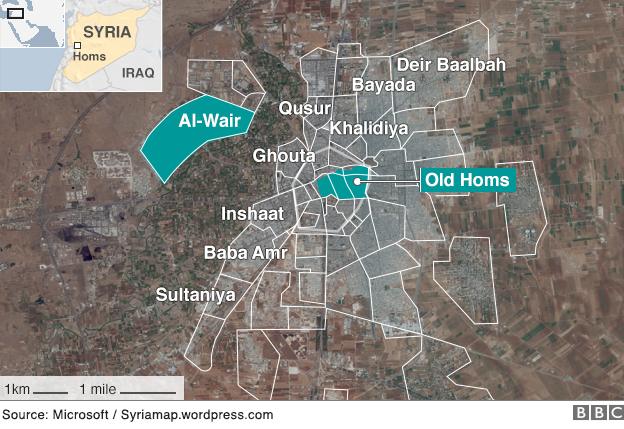Syria conflict: Rebels leave Homs under truce
- Published
Lyse Doucet reports from inside Homs as fighters and families leave the city
Syrian rebels have begun evacuating the last district they control in the city of Homs under a ceasefire deal reached with the government.
Those leaving al-Wair, under siege for almost three years, will travel to rebel-held areas of Idlib province.
Homs was once dubbed the "capital of the revolution" and saw some of the first protests of the 2011 uprising.
But the truce means the entire city returns to government control, in a boost for President Bashar al-Assad.
Buses arrived on Wednesday to transport fighters and their families out of the Homs suburb of al-Wair.
About 700 people, including rebel fighters and civilians, are due to depart throughout Wednesday, Homs governor Talal Barazi said.
Fighters linked to al-Qaeda are among those due to leave, but moderate groups who have accepted the ceasefire are expected to remain.

Under the UN-backed deal, food aid has reached the suburb for the first time in nearly a year.
The Syrian Red Crescent tweeted, external (in Arabic) that its teams were operating in the area but few details were available on the conditions on the ground.
"We wish for the best," said one resident. "What do we want but safety?"

A bitter landmark: Lyse Doucet, BBC News, Homs

Aid workers helped the evacuation from al-Wair
On Wednesday the long road into al-Wair was lined with passenger buses, UN cars, ambulances, and Syrian military vehicles. A buffer zone at the entrance was packed with Syrian soldiers and officials, blue-vested UN staff, and the red coats of the Syrian Red Crescent.
The first to leave were dozens of injured, young and old, hobbling on crutches or bent in wheelchairs.
Then came 100 families of the fighters, some tearful to be leaving their homes, many desperate to be free of a punishing siege.
The last to board waiting buses were more than 300 fighters from hardline groups who reject the ceasefire but agreed not to disrupt it.
The ceasefire is a bitter landmark for those who protested and fought in a city once called "capital of the revolution".
For others, it's the only way forward to begin to end a devastating war and to ease the suffering of civilians who have paid a heavy price.

An estimated 75,000 people still live in al-Wair, down from about 300,000 before the start of the Syrian conflict.
As part of the deal, the Syrian authorities this week said they released 35 opposition fighters detained in Homs.
Homs has seen some of the fiercest fighting of Syria's four-year civil war
The ceasefire involves rebels withdrawing from al-Wair in exchange for the Syrian government lifting their siege of the district.
Government police, but not troops, will then re-enter, Homs governor Talal Barazzi told AFP.

Q&A: The Homs ceasefire
Is this a victory for Bashar al-Assad? The withdrawal of the last remaining rebels from al-Wair is a blow to the opposition because it gives the government complete control over what was once the centre of the uprising against the president.
Has it come about because of Russia's intervention? The Syrian military launched an offensive on rebel-held areas outside Homs after Russia began its air campaign two months ago. But al-Wair fell because its residents were besieged for almost three years, coming under continuous and heavy bombardment and receiving only limited and irregular supplies.
Does this offer hope for a wider peace deal? Local ceasefires like the one that allowed the al-Wair withdrawal - negotiated by Syrians, rather than involving outside states - may be the most effective way of gradually bringing peace to the country.
Why are rebel and opposition factions meeting in Saudi Arabia? Leading opposition politicians and rebels are for the first time meeting in an attempt to agree a common position ahead of peace talks with the government, which world powers want to start in Vienna next month.
Will those talks lead to peace talks with the government? Analysts say trying to get the disparate factions to agree to the same platform and negotiate as one unit will prove very difficult, if not impossible.

A similar ceasefire last year in another opposition-held area of Homs, the Old City, drew criticism from activists as effectively being a surrender forced by a relentless bombardment.
But some activists have defended the truce struck in al-Wair on the grounds that some groups will be allowed to keep their own weapons and control over their own communities.
In Saudi Arabia, representatives from Syria's splintered opposition have meanwhile begun a meeting to try to form a unified front to negotiate with the Syrian government.
Divisions have emerged, with the powerful Islamist faction Ahrar al-Sham calling for the Syrian government to be dissolved and President Assad put on trial, but correspondents say there is nonetheless optimism that a common position will be found.

Homs: Syrian revolution's fallen 'capital'
Protests against President Assad erupt in Homs in mid-March 2011
By the middle of 2012, up to a fifth of Homs is in opposition hands
In the same year the Syrian military launches an operation to crush resistance. Districts are bombarded, leaving civilians trapped, and the government re-takes key districts
By January 2014, only the Old City and al-Wair are still held by the opposition. A ceasefire is reached in the Old City after warnings about the dire humanitarian situation
In 2015, a similar deal sees rebels begin evacuating al-Wair

Are you in Homs or know someone who is? Are you affected by the issues raised in this story? Email haveyoursay@bbc.co.uk, external with your experience.
If you are willing to speak further to a BBC journalist, please include a contact telephone number.
Email your pictures to yourpics@bbc.co.uk, external, upload them here, external, tweet them to @BBC_HaveYourSay, external or text 61124. If you are outside the UK, send them to the international number +44 7624 800 100.
Or WhatsApp us on +44 7525 900971
Read our terms and conditions.